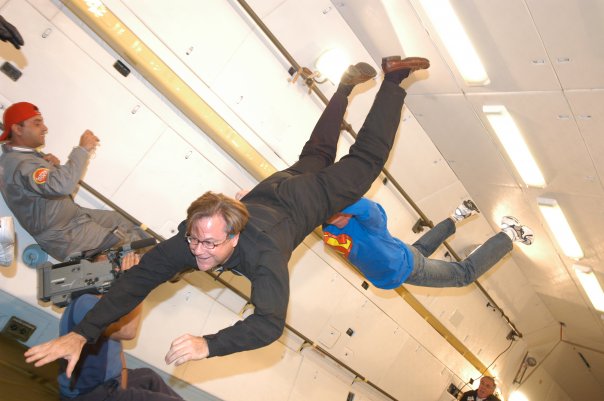
Last year, I plunked down a $20,000 deposit with Richard Branson's Virgin Galactic Airways for a $200,000 suborbital space flight scheduled to leave in 2013; I am passenger #610 in line. In the meantime, while X Prize-winner Burt Rutan builds and tests SpaceShipTwo, the 8-person craft that will take me 70 miles above the earth, I wanted to get some related experience. Weightlessness will be part of my space flight.
In Russia, you can experience simulated bursts of weightlessness (parabolic flight) in an old Ilyushin 76 cargo plane, the same aircraft in which Russian cosmonauts train. So, after obtaining a Visa, I was off to Moscow. My biggest concern was nausea. Pre-flight literature says 30% of fliers typically become sick. In a group of a dozen, that means four, and I was convinced I would be one of them.
Times are still tough for the Russians. Soldiers and scientists are receiving reduced pay, if any, while their equipment sits idle. Western adventure booking agents pump welcome money into the Russian economy while giving tourists thrills available few other places on earth. I booked my trip (retail: about $7,000) through Space Adventures, the same Arlington, VA, firm that sells $30 million seats on Soyuz rockets to the International Space Station.
My flight day started with an early wake-up call (5 a.m.); there are practical matters. The drive to the Yuri Gagarin Cosmonaut Training Center in Star City, 30 miles away, needs to get done before rush hour. Breakfast is also practical: bread, bland muffins--no eggs, meat or juice. That stuff floating around the plane later, we were told, would not be pleasant. We were also advised to take the anti-motion drug Dramamine.
Parabolic flight is disorienting. You climb to 35,000 feet, the cruising altitude of a jetliner, then go into a controlled 40-degree dive for about 30 seconds. During that half-minute, you are weightless. The plane then pulls up at about 26,000 feet, and climbs again. In that phase, you feel a little more than two Gs--or twice your body weight. You alternate between weightlessness and positive Gs for 10 full parabolas. There are no windows, so you can't much tell what's happening outside other than by the forces buffeting your body. For comfort, the roomy cargo area of the IL-76 is fitted with thick floor cushions.
We fly in two separate groups; I am in the first. As we top out at 35,000 feet, we begin to come up off the floor. Thinking I have to use force, I push off fairly decisively. Wrong move! A second later I bang my head on the 12-foot-high ceiling. When weightless, you quickly learn that the force and angle of what you last touch directly determines your trajectory--and there's no correcting, as one might do when swimming. While fumbling with a small bag, it gets away from me. My first instinct is to breast-stroke toward it, which I do. Result: I go nowhere, just float in place as the bag bounces off the wall!
All my life I have wanted to experiment with water while weightless, as I had seen astronauts do on early missions. On our fifth parabola, I pull a sealed bottle of Evian from my flight suit and open it. The droplets disperse in shiny, marble-sized balls--each a different size--and float about the cabin. I try to catch as many as possible in my mouth, as if they are M&Ms. Fascinating! We do flips and are "thrown" like forward passes toward the front of the cabin by Russian technicians. By the last parabola, however, everyone is beginning to look a little green.
Later that afternoon, after touring the Gagarin Center (which includes life-sized, working mock-ups of the MIR and International Space Station), we get word that five people in the second group had taken ill, a few seriously enough to vomit. I'm suddenly glad to have been on the first flight. Only one in our group got sick, and he had the decency not to heave.
A U.S. program, run by Zero Gravity Corp., also offers weightless flights, using retrofitted Boeing 727s. But these aircraft are smaller and much more cramped then the Ilyushins, so they don't provide as thrilling a weightless experience. The U.S. flights are cheaper, though, and don't require the hassle (and cost) of flying to Russia.
Photo courtesy of Space Adventures.